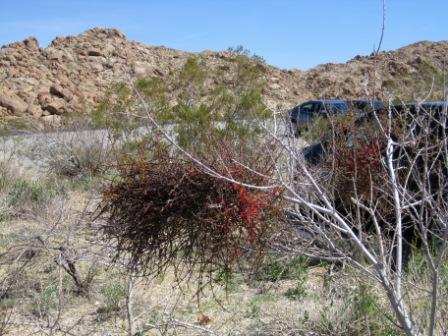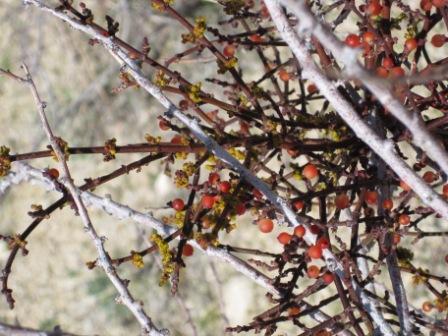

While looking over photos from my California desert trip this spring, I came upon this curious plant:

You can see most of the plant is dead (white branches), though there are two clumps of vigorous growth, shown up close here:

What’s going on here?
Answer Monday!


Published by

Linda Chalker-Scott
Dr. Linda Chalker-Scott has a Ph.D. in Horticulture from Oregon State University and is an ISA certified arborist and an ASCA consulting arborist. She is WSU’s Extension Urban Horticulturist and an Emerita Professor in the Department of Horticulture. She conducts research in applied plant and soil sciences, publishing the results in scientific articles and university Extension fact sheets.
Linda also is the award-winning author of five books: the horticultural myth-busting The Informed Gardener (2008) and The Informed Gardener Blooms Again (2010) from the University of Washington Press and Sustainable Landscapes and Gardens: Good Science – Practical Application (2009) from GFG Publishing, Inc., and How Plants Work: The Science Behind the Amazing Things Plants Do from Timber Press (2015). Her latest effort is an update of Art Kruckeberg’s Gardening with Native Plants of the Pacific Northwest from UW Press (2019).
In 2018 Linda was featured in a video series – The Science of Gardening – produced by The Great Courses. She also is one of the Garden Professors – a group of academic colleagues who educate and entertain through their blog and Facebook pages. Linda’s contribution to gardeners was recognized in 2017 by the Association for Garden Communicators as the first recipient of their Cynthia Westcott Scientific Writing Award.
"The Garden Professors" Facebook group - www.facebook.com/groups/GardenProfessors
Books: http://www.sustainablelandscapesandgardens.com
View all posts by Linda Chalker-Scott


Some kind of epiphyte?
Looks a lot like Mesquite mistletoe (Phoradendron californicum). Phainopepla birds have a very close relationship with the mistletoe feeding on the berries and dispersing the seeds to other hosts.
Are you sure the host plant was dead? That usually leads quickly to the death of the parasite due to lack of water. Might the host just be dormant?
I agree with Bob. It’s mistletoe, but I have the same question about the water. Could it be that the transpiration through the mistletoe provides enough of a vacuum to keep the water moving through the dead xylem cells?
I third the mistletoe suggestion.
There’s a mistletoe bird here in Australia that acts as the main dispersal mechanism for our native mistletoes. It’s behaviour is a bit different to other birds that also feed on mistletoe because it actually wipes it’s backside directly onto branches when it evacuates, making the chances of the poo-encased mistletoe seed sticking to the tree branch so much higher. Clever, hey?
There are two plant here. Everyone I know calls the red one as a desert mistletoe (Phoradendron californican). It is a major source of food for the phainopepla, a beautiful little bird. It is unlikely that the host plant is dead. Desert plants often look as if they are dead. They are just waiting for the right amount of water at the right time so they can display their beauty. Just like the host plant these desert mistletoes must have some kind of adaptation so that they can survive on small, infrequent amounts of water.
The clump that’s growing was sprayed with compost tea.
🙂